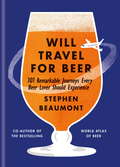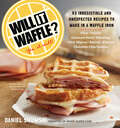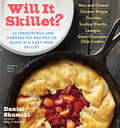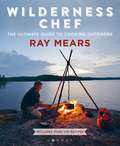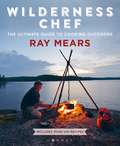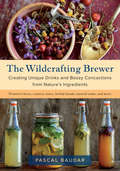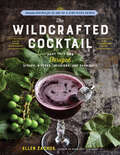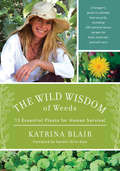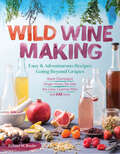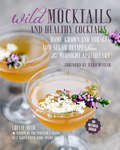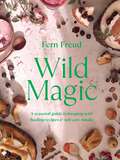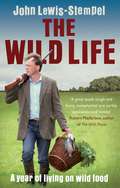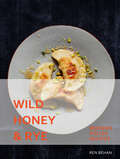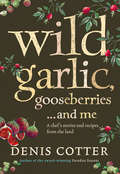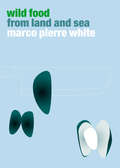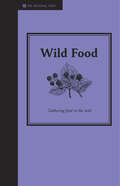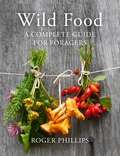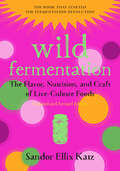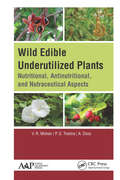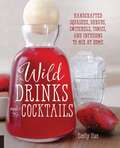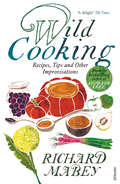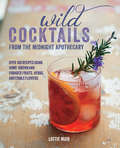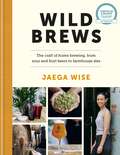- Table View
- List View
Will Travel For Beer: 101 Remarkable Journeys Every Beer Lover Should Experience
by Stephen BeaumontFrom the walkable breweries of Ashville, North Carolina, to the Ølfestival in Copenhagen, Oktoberfest in Brazil to the breweries of Beijing, discover 101 traditional, quirky, absurd, must-visit beer destinations across the globe. Find the world's most romantic pub crawl in Bruges, drink beer in paradise in Latin America or step into Germany via Bangkok, Thailand. Complete with tasting notes, drinking tips and handy address lists, this is the perfect gift for both beer enthusiasts and keen travellers alike.
Will It Waffle?: 53 Irresistible and Unexpected Recipes to Make in a Waffle Iron (Will It...?)
by Daniel Shumski&“This book is pure culinary fun!&” —Gale Gand, pastry chef, author, restaurateur, and TV personalityCooking food on your waffle iron is not just a novelty but an innovation that leads to a great end product, all while giving the cook the bonus pleasure of doing something cool, fun, and vaguely nerdy (or giving a reluctant eater―your child, say―a great reason to dig in). Why waffle?The Ease! Waffled Bacon and Eggs: First, waffle the bacon—fast, crisp, and no burnt edges—then the eggs, for lacy whites and perfect yolks (thanks, bacon fat).The Melt! Waffled Macaroni and Cheese: Waffled leftover mac &‘n&’ cheese is a decadent grilled cheese sandwich—golden, buttery exterior and soft, cheesy insides. The Dimples! Spaghetti and Waffled Meatballs: That&’s right—cook meatballs in a waffle iron and create dimples where the sauce can pool. The Cool Factor! Waffled Oatmeal Chocolate Chip Cookies: Break out the waffle iron when it&’s time for dessert, and make soft, gooey cookies with grid marks. No oven required.&“Dan Shumski&’s genius lies in asking not what his waffler can do for him, but what he can stuff into his waffler, and following that question through to all of its delicious conclusions&”—J.Kenji Lopez-Alt (The Food Lab and seriouseats.com)
Will It Skillet?: 53 Irresistible and Unexpected Recipes to Make in a Cast-Iron Skillet (Will It...?)
by Daniel ShumskiDiscover a new world of cast-iron cooking. From Dan Shumski, who last applied his out-of-the-box food-loving sensibility to Will It Waffle?, here are 53 surprising, delicious, and ingenious recipes for the cast-iron skillet. Savor the simplicity of Toast with Olive Oil and Tomato, because you just can&’t achieve that perfect oil-toasted crust in a toaster. For Homemade Corn Tortillas, no special equipment required—use the pan to flatten and cook them. (Then serve your tortillas with Single-Skillet Carnitas or Charred Tomato Salsa—or make Chilaquiles.) Take popcorn to another level with clarified butter. Enjoy a Spinach and Feta Dip that stays warm from the residual heat of the pan. Plus pastas that come together in one skillet—no separate boiling required; perfectly charred roasted vegetables; beautiful breads and pizzas; and luscious desserts from a giant chocolate chip cookie to the sophisticated Layered Crepe Torte with Dark Chocolate and Raspberry Jam. Includes detailed information on buying, seasoning, and caring for your cast-iron skillet—and turning it into a nonstick kitchen workhorse.
Wilderness Chef: The Ultimate Guide to Cooking Outdoors
by Ray MearsGather round an open fire. Share delicious food inspired by the outdoors and infused with age-old wisdom. This is living. This is the way of the wilderness chef.Ray Mears has spent his life travelling the world, living with and learning from trackers, adventurers and indigenous peoples in the desert, the rainforests and the Arctic north. In this book he presents us with a delicious array of his most popular and enduring recipes, tried-and-tested for all levels of skill and in all conditions, from quick and tasty meals to opulent gourmet feasts. Opening with advice on setting up your outdoor kitchen and essential cooking techniques, Ray shows how to assess your ingredients, light a fire, cook in ashes and leaves, steam, smoke, and build a ground oven. He then shares his fabulous and enjoyable recipes, including:- easy ideas that children and grownups can try out (campfire s'mores, wilderness hot dog, egg on a stick, lemon chicken wrapped in dock leaves) - gourmet meals (Italian hunter's rabbit, succulent split-stick roasted salmon) - recipes learned from bushmen and indigenous peoples around the world (potjiekos, canoe country pancakes, fragrant and intense Gurkha curry)Woven throughout are colourful stories of Ray's cooking around the world, from baking a birthday cake using ingredients sourced in the rainforest, to steaming fish Maori-style using bags crafted from Bull Kelp, and pulling a giant Emu leg drumstick out of a ground oven built by a Pitjantjatjara elder in the Central Australian desert. This is a practical and inspiring book drawing on the love of the outdoors, cooking in the open air and creating delicious food from scratch.
Wilderness Chef: The Ultimate Guide to Cooking Outdoors
by Ray MearsGather round an open fire. Share delicious food inspired by the outdoors and infused with age-old wisdom. This is living. This is the way of the wilderness chef.Ray Mears has spent his life travelling the world, living with and learning from trackers, adventurers and indigenous peoples in the desert, the rainforests and the Arctic north. In this book he presents us with a delicious array of his most popular and enduring recipes, tried-and-tested for all levels of skill and in all conditions, from quick and tasty meals to opulent gourmet feasts. Opening with advice on setting up your outdoor kitchen and essential cooking techniques, Ray shows how to assess your ingredients, light a fire, cook in ashes and leaves, steam, smoke, and build a ground oven. He then shares his fabulous and enjoyable recipes, including:- easy ideas that children and grownups can try out (campfire s'mores, wilderness hot dog, egg on a stick, lemon chicken wrapped in dock leaves) - gourmet meals (Italian hunter's rabbit, succulent split-stick roasted salmon) - recipes learned from bushmen and indigenous peoples around the world (potjiekos, canoe country pancakes, fragrant and intense Gurkha curry)Woven throughout are colourful stories of Ray's cooking around the world, from baking a birthday cake using ingredients sourced in the rainforest, to steaming fish Maori-style using bags crafted from Bull Kelp, and pulling a giant Emu leg drumstick out of a ground oven built by a Pitjantjatjara elder in the Central Australian desert. This is a practical and inspiring book drawing on the love of the outdoors, cooking in the open air and creating delicious food from scratch.
The Wildcrafting Brewer: Creating Unique Drinks and Boozy Concoctions from Nature's Ingredients
by Pascal BaudarPrimitive beers, country wines, herbal meads, natural sodas, and more The art of brewing doesn’t stop at the usual ingredients: barley, hops, yeast, and water. In fact, the origins of brewing involve a whole galaxy of wild and cultivated plants, fruits, berries, and other natural materials, which were once used to make a whole spectrum of creative, fermented drinks. Now fermentation fans and home brewers can rediscover these “primitive” drinks and their unique flavors in The Wildcrafting Brewer. Wild-plant expert and forager Pascal Baudar’s first book, The New Wildcrafted Cuisine, opened up a whole new world of possibilities for readers wishing to explore and capture the flavors of their local terroir. The Wildcrafting Brewer does the same for fermented drinks. Baudar reveals both the underlying philosophy and the practical techniques for making your own delicious concoctions, from simple wild sodas, to non-grape-based “country wines,” to primitive herbal beers, meads, and traditional ethnic ferments like tiswin and kvass. The book opens with a retrospective of plant-based brewing and ancient beers. The author then goes on to describe both hot and cold brewing methods and provides lots of interesting recipes; mugwort beer, horehound beer, and manzanita cider are just a few of the many drinks represented. Baudar is quick to point out that these recipes serve mainly as a touchstone for readers, who can then use the information and techniques he provides to create their own brews, using their own local ingredients. The Wildcrafting Brewer will attract herbalists, foragers, natural-foodies, and chefs alike with the author’s playful and relaxed philosophy. Readers will find themselves surprised by how easy making your own natural drinks can be, and will be inspired, again, by the abundance of nature all around them.
The Wildcrafted Cocktail: Make Your Own Foraged Syrups, Bitters, Infusions, and Garnishes; Includes Recipes for 45 One-of-a-Kind Mixed Drinks
by Ellen ZachosMore than 50 recipes for garnishes, syrups, infusions, juices, and bitters using commonly found foraged ingredients serve as the foundation for 45 unique and delicious botanical cocktail recipes.
The Wild Wisdom of Weeds: 13 Essential Plants for Human Survival
by Katrina Blair Sandor Ellix KatzThe Wild Wisdom of Weeds is the only book on foraging and edible weeds to focus on the thirteen weeds found all over the world, each of which represents a complete food source and extensive medical pharmacy and first-aid kit. More than just a field guide to wild edibles, it is a global plan for human survival. When Katrina Blair was eleven she had a life-changing experience where wild plants spoke to her, beckoning her to become a champion of their cause. Since then she has spent months on end taking walkabouts in the wild, eating nothing but what she forages, and has become a wild-foods advocate, community activist, gardener, and chef, teaching and presenting internationally about foraging and the healthful lifestyle it promotes. Katrina Blair’s philosophy in The Wild Wisdom of Weeds is sobering, realistic, and ultimately optimistic. If we can open our eyes to see the wisdom found in these weeds right under our noses, instead of trying to eradicate an “invasive,” we will achieve true food security. The Wild Wisdom of Weeds is about healing ourselves both in body and in spirit, in an age where technology, commodity agriculture, and processed foods dictate the terms of our intelligence. But if we can become familiar with these thirteen edible survival weeds found all over the world, we will never go hungry, and we will become closer to our own wild human instincts—all the while enjoying the freshest, wildest, and most nutritious food there is. For free! The thirteen plants found growing in every region across the world are: dandelion, mallow, purslane, plantain, thistle, amaranth, dock, mustard, grass, chickweed, clover, lambsquarter, and knotweed. These special plants contribute to the regeneration of the earth while supporting the survival of our human species; they grow everywhere where human civilization exists, from the hottest deserts to the Arctic Circle, following the path of human disturbance. Indeed, the more humans disturb the earth and put our food supply at risk, the more these thirteen plants proliferate. It’s a survival plan for the ages. Including over one hundred unique recipes, Katrina Blair’s book teaches us how to prepare these wild plants from root to seed in soups, salads, slaws, crackers, pestos, seed breads, and seed butters; cereals, green powders, sauerkrauts, smoothies, and milks; first-aid concoctions such as tinctures, teas, salves, and soothers; self-care/beauty products including shampoo, mouthwash, toothpaste (and brush), face masks; and a lot more. Whether readers are based at home or traveling, this book aims to empower individuals to maintain a state of optimal health with minimal cost and effort.
Wild Winemaking: Easy & Adventurous Recipes Going Beyond Grapes, Including Apple Champagne, Ginger–Green Tea Sake, Key Lime–Cayenne Wine, and 142 More
by Richard W. BenderThese 148 easy and creative home winemaking recipes forgo specialty grapes and instead use a range of readily available fruits, vegetables, flowers, and herbs to create combinations such as Black Currant Peach, Ginger Green Tea Saké, and Vanilla Rose Petal.
Wild Mocktails and Healthy Cocktails: Home-grown and foraged low-sugar recipes from the Midnight Apothecary
by Lottie MuirCreate delicious mocktails and low-sugar cocktails, using home-grown and foraged ingredients. Includes a foreword by Jekka McVicar. Award-winning cocktail-maker and gardener Lottie Muir brings you another selection of wonderfully wild and flavourful concoctions from her pop-up bar, The Midnight Apothecary. For this new repertoire of drinks, Lottie set herself a threefold challenge: to achieve the same amount of pleasure and balance that refined sugar provides in the taste and mouth-feel of a cocktail, to create new aromatic and bitter-forward drinks, and to make delicious new mocktails for those who want to consume no, or less, alcohol. Lottie has created delicious infusions, cordials, sodas, shrubs, bitters, teas and tonics that can be mixed alcohol free as mocktails – try out the Cherry Blossom and Flowering Currant Cordial, the Thyme and Licorice Syrup, or the Iced Spring Tonic Tea – or added to your favourite spirits to create a magical take on old-time classics, such as the Wild Negroni or the Windfall Punch. There is the perfect drink for any time of the year and whatever your mood, so whether it is Dry January mocktails that you need, no-added-sugar fun, or the restorative powers of an indulgent cocktail, Lottie’s plant-powered potions hit the right spot.
Wild Magic: A seasonal guide to foraging with healing recipes
by Fern FreudCome along on a journey through the woods, over the fields and into the kitchen, to find nourishing ingredients to enjoy through the seasons.Wild Magic invites you to take a deep breath and reconnect with nature, discover the joy of seasonal eating and use the healing power of plants for self-care.From a fizzy drink of elderflower cordial to a warming bowl of mushroom noodles and melting wild garlic muffins to indulgent wild currant doughnuts, these 80 healing recipes and rituals that will make you fall in love with the wilderness that surrounds you in the city as the country, and embrace the beauty of slow living all year round.
The Wild Life: A Year of Living on Wild Food
by John Lewis-StempelThe Wild Life is John Lewis-Stempel's account of twelve months eating only food shot, caught or foraged from the fields, hedges, and brooks of his forty-acre farm. Nothing from a shop and nothing raised from agriculture. Could it even be done?We witness the season-by-season drama as the author survives on Nature's larder, trains Edith, a reluctant gundog, and conjures new recipes. And, above all, we see him get closer to Nature. Because, after all, you're never closer to Nature than when you're trying to kill it or pick it.Lyrical, observant and mordantly funny, The Wild Life is an extraordinary celebration of our natural heritage, and a testament to the importance of getting back to one's roots - spiritually and practically.
Wild Honey and Rye: Modern Polish Recipes
by Ren BehanIn this refreshing approach to Polish cuisine, food writer and blogger Ren Behan takes us on a journey to discover the new tastes of her beloved culinary heritage.
Wild Garlic, Gooseberries and Me: A Chef's Stories And Recipes From The Land
by Denis CotterFollowing the successes of Café Paradiso and the award-winning Paradiso Seasons, Denis Cotter is back with an evocative, witty collection of tales and a superb range of exciting and delicious vegetarian recipes.
Wild Food From Land And Sea (Ebury Great Cooks Ser.)
by Marco Pierre WhiteWild Food from Land and Sea contains over eighty main recipes, plus sauces, vegetables and garnishes, many of which can be made in advance. There are recipes for starters, fish dishes, meat dishes, puddings, pasta, risottos and pastries. This book reveals that behind the hype, there is a professional, dedicated chef of astonishing talent. His mastery is based on the solid foundations of French classical cuisine, but it is informed by a modern feeling for the importance of the highest quality and freshness, by a receptivity to influences from around the world, by exquisite simplicity and profund originality. Above all, the book aims to make accessible the secrets of his success to all amateur cooks, and is full of brilliant tips based on his incomparable feeling for the potential in natural foods from land and see.Marco's innumerable tips on adapting recipes to suit your ingredients ensure that even amateurs will be able to serve delicious food with style and entertain with confidence.
Wild Food: Gathering And Foraging Food Outdoors (Countryside Ser.)
by Jane EastoeDiscover the wonders of wild food, from berries to mushrooms to fresh herbs – all of which are wonderful foods free on our doorstep. The author Jane Eastoe shows you how to find, identify and cook a range of wild food, including nuts, seeds, roots, fruit, flowers, seaweed, fungi and plant leaves. Elderberry flowers can be used for making cordial, nettles make delicious soup and sloe gin and horseradish sauce are just two great traditional recipes that can be made from the hedgerow larder. There are dangers in some wild plants and the author gives guidance on how to pick safely (for example cooking elderberries destroys the toxins present but the leaves, bark or roots of the elder should never be eaten). Mushrooms are notoriously difficult to get right so Jane Eastoe gives you the key dos and don'ts on mushroom picking. What to take on a culinary walk in the countryside? What foods are available in what season? What's the nutritional value of certain wild foods? All these questions and many more are answered by the author to ensure you make the most of every culinary walk through the countryside.
Wild Food: A Complete Guide for Foragers
by Roger Phillips'I can safely say that if I hadn't picked up this book some twenty years ago I wouldn't have eaten as well, or even lived as well, as I have. It inspired me then and it inspires me now' Hugh Fearnley-WhittingstalWild food is all around us, growing in our hedgerows and fields, along river banks and seashores, even on inhospitable moorland. In Roger Phillips and Martyn Rix's Wild Food, hundreds of these plants are clearly identified, with colour photography and a detailed description. This definitive guide also gives us fascinating information on how our ancestors would have used the plant as well as including over 100 more modern recipes for delicious food and drinks. From berries, herbs and mushrooms to wild vegetables, salad leaves, seaweed and even bark, this book will inspire you to start cooking with nature's free bounty.
Wild Fermentation: The Flavor, Nutrition, and Craft of Live-Culture Foods, 2nd Edition
by Sandor Ellix Katz Sally Fallon MorellThe Book That Started the Fermentation Revolution Sandor Ellix Katz, winner of a James Beard Award and New York Times bestselling author, whom Michael Pollan calls the “Johnny Appleseed of Fermentation” returns to the iconic book that started it all, but with a fresh perspective, renewed enthusiasm, and expanded wisdom from his travels around the world. This self-described fermentation revivalist is perhaps best known simply as Sandorkraut, which describes his joyful and demystifying approach to making and eating fermented foods, the health benefits of which have helped launch a nutrition-based food revolution. Since its publication in 2003, and aided by Katz’s engaging and fervent workshop presentations, Wild Fermentation has inspired people to turn their kitchens into food labs: fermenting vegetables into sauerkraut, milk into cheese or yogurt, grains into sourdough bread, and much more. In turn, they’ve traded batches, shared recipes, and joined thousands of others on a journey of creating healthy food for themselves, their families, and their communities. Katz’s work earned him the Craig Clairborne lifetime achievement award from the Southern Foodways Alliance, and has been called “one of the unlikely rock stars of the American food scene” by The New York Times. This updated and revised edition, now with full color photos throughout, is sure to introduce a whole new generation to the flavors and health benefits of fermented foods. It features many brand-new recipes—including Strawberry Kvass, African Sorghum Beer, and Infinite Buckwheat Bread—and updates and refines original recipes reflecting the author’s ever-deepening knowledge of global food traditions that has influenced four-star chefs and home cooks alike. For Katz, his gateway to fermentation was sauerkraut. So open this book to find yours, and start a little food revolution right in your own kitchen. Praise for Sandor Ellix Katz and his books: “The Art of Fermentation is an extraordinary book, and an impressive work of passion and scholarship.”—Deborah Madison, author of Local Flavors “Sandor Katz has proven himself to be the king of fermentation.”—Sally Fallon Morell, President, The Weston A. Price Foundation “Sandor Katz has already awakened more people to the diversity and deliciousness of fermented foods than any other single person has over the last century.”—Gary Paul Nabhan, author of Growing Food in a Hotter, Drier Land “The fermenting bible.” — Newsweek “In a country almost clinically obsessed with sterilization Katz reminds us of the forgotten benefits of living in harmony with our microbial relatives.” — Grist
Wild Edible Underutilized Plants: Nutritional, Antinutritional, and Nutraceutical Aspects
by V. R. Mohan P. S. Tresina A. DossWild Edible Underutilized Plants explores the role of wild plants in human nutrition—a topic that continues to take precedence in various fields of research. Despite the increasing evidence on past and present nutritional roles of wild edible plants, the use of these resources is often overlooked and neglected in countless policy areas. This book emphasizes the importance of these plants and explores their relevance to sustainable agriculture, biodiversity, and public health in different agro-ecological regions. The book implements a conceptual approach to wild plants, focusing on the benefits of incorporating these plants into people’s diets and daily lives and the advantage they will provide to future generations. The book also addresses widespread issues of scarcity, proposing solutions that promote food sovereignty and security. The book begins by first discussing the nutritional aspects of wild edible plants to explore their value as a source of vitamins, antioxidants, fiber, minerals, and other nutrients. It then continues to elaborate on the anti-nutritional elements of these plants, providing a comprehensive overview of their utility.
Wild Edible Underutilized Plants: Nutritional, Antinutritional, and Nutraceutical Aspects
by V. R. Mohan P. S. Tresina A. DossWild Edible Underutilized Plants explores the role of wild plants in human nutrition—a topic that continues to take precedence in various fields of research. Despite the increasing evidence on past and present nutritional roles of wild edible plants, the use of these resources is often overlooked and neglected in countless policy areas. This book emphasizes the importance of these plants and explores their relevance to sustainable agriculture, biodiversity, and public health in different agro-ecological regions. The book implements a conceptual approach to wild plants, focusing on the benefits of incorporating these plants into people’s diets and daily lives and the advantage they will provide to future generations. The book also addresses widespread issues of scarcity, proposing solutions that promote food sovereignty and security. The book begins by first discussing the nutritional aspects of wild edible plants to explore their value as a source of vitamins, antioxidants, fiber, minerals, and other nutrients. It then continues to elaborate on the anti-nutritional elements of these plants, providing a comprehensive overview of their utility.
Wild Drinks & Cocktails: Handcrafted Squashes, Shrubs, Switchels, Tonics, and Infusions to Mix at Home
by Emily Han<p> <b>Create your own handcrafted drinks and cocktails using local, fresh, or foraged ingredients.</b> </p> <p> Tired of boring, artificial, too-sweet drinks? Go wild! It's time to embrace drinks featuring local, fresh, or foraged ingredients. It's easy with <i>Wild Drinks & Cocktails</i>. </p> <p> Using ingredients you can find in your own backyard, farm, or local market, you can create artisan drinks that will leave you feeling refreshed and even revitalized. Learn useful fermentation techniques to make your own kefi,and homemade soda. Brew your own teas, mix your own squashes, shrubs, switchels, tonics, and infusions. You can even use the recipes to create powerful and healthful craft cocktails. </p> <p> Craft drink expert Emily Han creates unique flavors in the 100 drink recipes, each with powerful health benefits, along with a sentimental nod to drinks of another era. <i>Wild Drinks & Cocktails</i> teaches you the techniques you need to know to handcraft your own infused waters, syrups, vinegar drinks, spirits, wines, and sodas. </p> <p> Join the drink renaissance with <i>Wild Drinks & Cocktails.</i> </p> <p> "Emily Han's carefully crafted book,<i> Wild Drinks & Cocktails</i> dispels the common wisdom of great drinks are only to be built by professionals. These simple cocktails are not short of brilliant- from locally-gathered ingredients constructed with our own, very capable hands, no pro's needed!" - Warren Bobrow, author of Apothecary Cocktails, Whiskey Cocktails, and Bitters and Shrub Syrup Cocktails </p>
Wild Drinks And Cocktails: Handcrafted Squashes, Shrubs, Switchels, Tonics, And Infusions To Mix At Home
by Emily Han<p> <b>Create your own handcrafted drinks and cocktails using local, fresh, or foraged ingredients.</b> </p> <p> Tired of boring, artificial, too-sweet drinks? Go wild! It's time to embrace drinks featuring local, fresh, or foraged ingredients. It's easy with <i>Wild Drinks & Cocktails</i>. </p> <p> Using ingredients you can find in your own backyard, farm, or local market, you can create artisan drinks that will leave you feeling refreshed and even revitalized. Learn useful fermentation techniques to make your own kefi,and homemade soda. Brew your own teas, mix your own squashes, shrubs, switchels, tonics, and infusions. You can even use the recipes to create powerful and healthful craft cocktails. </p> <p> Craft drink expert Emily Han creates unique flavors in the 100 drink recipes, each with powerful health benefits, along with a sentimental nod to drinks of another era. <i>Wild Drinks & Cocktails</i> teaches you the techniques you need to know to handcraft your own infused waters, syrups, vinegar drinks, spirits, wines, and sodas. </p> <p> Join the drink renaissance with <i>Wild Drinks & Cocktails.</i> </p> <p> "Emily Han's carefully crafted book,<i> Wild Drinks & Cocktails</i> dispels the common wisdom of great drinks are only to be built by professionals. These simple cocktails are not short of brilliant- from locally-gathered ingredients constructed with our own, very capable hands, no pro's needed!" - Warren Bobrow, author of Apothecary Cocktails, Whiskey Cocktails, and Bitters and Shrub Syrup Cocktails </p>
Wild Cooking: Recipes, Tips and Other Improvisations in the Kitchen
by Richard MabeyRichard Mabey's sparky, offbeat book is about canny and inventive making-do, or 'busking in the kitchen'. Whether creating a cassoulet which uses English ingredients, making bread from chestnuts or slow-cooking a Peking duck in front of an ancient fan heater, he encourages us to be daring and imaginative in our cooking and our approach to food. Although it contains wonderful, mouth-watering recipes like broad bean hummus, pumpkin soup and fillet-steak hearts this is more than a recipe book - it is a guide to a whole new way of thinking that embraces scrumping, celebrates picnics, and revels in saving energy wherever it can, whether that's by one-pot feasts or cooling on car radiators. After all, if you care about food 'life's too short not to stuff a mushroom'.Previously published in hardback as The Full English Cassoulet.
Wild Cocktails from the Midnight Apothecary: Over 100 recipes using home-grown and foraged fruits, herbs, and edible flowers
by Lottie MuirLearn how to make exquisite home-grown cocktails.
Wild Brews: The craft of home brewing, from sour and fruit beers to farmhouse ales
by Jaega WiseProduced using a mixture of naturally occurring yeasts and bacteria, wild fermented beers offer the 'fine dining' of the beer world. These beers are how beer tasted 200 years ago, before brewing was industrialised, and are enjoying a worldwide revival. Jaega Wise, head brewer at East London's Wild Card Brewery and presenter of Amazon Prime's Beermasters, is one of the UK's experts in wild fermentation. Here, she explains the science behind the brewing process and shares her recipes so that you can experiment at home. Learn how to brew, bottle, and age your beer in wooden barrels, and produce a range of different sour beer styles, farmhouse ales and fruit beers.Recipes and styles featured in the book include:- German Berliner Weisse (tart and refreshing) and Gose (salty and dry)- Belgian Lambics, gueze, Flanders red ale and fruit beers- French Farmhouse ales such as saison and biere de garde- Norwegian Farmhouse Ales including the Kveik IPA- English Old Ale Also included is a trouble-shooter section to guide you through what happens when wild yeast and bacteria get out of control and how to remedy it. Whether you are a beer geek or a home brewing novice, Wild Brews contains everything you need to replicate today's sour and wild beer styles at home.
